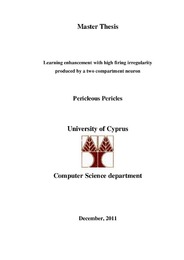| dc.contributor.advisor | Christodoulou, Chris | en |
| dc.contributor.author | Pericleous, Pericles | en |
| dc.coverage.spatial | Cyprus | en |
| dc.creator | Pericleous, Pericles | en |
| dc.date.accessioned | 2013-09-06T07:01:35Z | |
| dc.date.available | 2013-09-06T07:01:35Z | |
| dc.date.issued | 2011-12 | |
| dc.identifier.uri | https://gnosis.library.ucy.ac.cy/handle/7/13057 | en |
| dc.description | Thesis (Master) -- University of Cyprus, Faculty of Pure and Applied Sciences, Department of Computer Science, 2011. | en |
| dc.description.abstract | This thesis introduced a different approach in modeling and producing firing irregularity at high rates in order to investigate in an alternative way the claim of Christodoulou and Cleanthous [1] and Cleanthous and Christodoulou [2] that “high firing irregularity enhances learning”. More specifically, this thesis introduces a neural network consisting of two compartment leaky integrate-and-fire model as a neuron to investigate firstly whether this model at the neuron level can produce high firing irregularity at high rates and secondly at the network level whether it can enhance learning.
To achieve the above, the two compartment model suggested by Lansky and Rodriguez [3] and Bressloff [4] is implemented and tested for producing high firing irregularity at high rates. In addition the leaky integrate-and-fire model with partial somatic reset is implemented as part of this thesis for the purposes of comparison with the two compartment leaky integrate-and-fire model in producing high firing irregularity. The results showed that the two-compartment leaky integrate and fire model can produce firing irregularity in high rates.
The current model (i.e., two compartment leaky integrate-and-fire) is applied to a neural network trained with reward-modulated spike-timing-depended plasticity with eligibility trace introduced by Florian [5]. For the purposes of comparison, two other networks were implemented by this thesis. One consisted of leaky integrate-and-fire model with total reset (same with the one used by Florian, [5]) and one which consisted of leaky integrate-and-fire model with somatic partial reset (same with the one used by Christodoulou and Cleanthous [1] and Cleanthous and Christodoulou [2]). All three networks are forced to fire at high rates in order to test whether the high firing irregularity at high rates that can be produced by the two of the three networks (i.e., the one with the leaky integrate-and-fire nodes with somatic partial reset and the one with the two compartment leaky integrate-and-fire models) can achieve enhancement in learning as Christodoulou and Cleanthous [1] and Cleanthous and Christodoulou [2] claim. The results showed that the two networks that can fire irregularly at high rates performed better in terms of learning than the one that fires regularly. This is possible as high firing irregularity leads to more accurate correlation between pre-synaptic and post-synaptic spike timing and reinforcement signals.
Furthermore it was observed that the network that consisted of two compartment LIF nodes had better result than the network that consisted of LIF model with somatic partial reset as nodes. This cannot be easily explained because the different type of modeling sets limits in terms of comparison. Therefore, further investigation is needed in order to explore the reasons for the better performance by networks which consisted of two compartment LIF neurons.
Besides verifying the claim by Christodoulou‟s and Cleanthous [1] and Cleanthous and Christodoulou [2] that high firing irregularity enhances learning, this thesis also introduces o different way of neuron modeling that can achieve high firing irregularity at high rates. | en |
| dc.format.extent | xii, 125p. ; 30 cm. | en |
| dc.language.iso | eng | en |
| dc.publisher | Πανεπιστήμιο Κύπρου, Σχολή Θετικών και Εφαρμοσμένων Επιστημών / University of Cyprus, Faculty of Pure and Applied Sciences | |
| dc.rights | info:eu-repo/semantics/openAccess | en |
| dc.source.uri | https://ktree.cs.ucy.ac.cy/action.php?kt_path_info=ktcore.actions.document.view&fDocumentId=12947 | en |
| dc.title | Learning enhancement with high firing irregularity produced by a two compartment neuron | en |
| dc.type | info:eu-repo/semantics/masterThesis | en |
| dc.contributor.committeemember | Schizas, Christos N. | en |
| dc.contributor.committeemember | Pattichis, Constantinos | en |
| dc.contributor.committeemember | Christodoulou, Chris | en |
| dc.contributor.committeemember | Schizas, Christos N. | en |
| dc.contributor.committeemember | Pattihis, Constantinos | en |
| dc.contributor.department | Τμήμα Πληροφορικής / Department of Computer Science | |
| dc.author.faculty | Σχολή Θετικών και Εφαρμοσμένων Επιστημών / Faculty of Pure and Applied Sciences | |
| dc.author.department | Τμήμα Πληροφορικής / Department of Computer Science | |
| dc.type.uhtype | Master Thesis | en |
| dc.contributor.orcid | Christodoulou, Chris [0000-0001-9398-5256] | |

